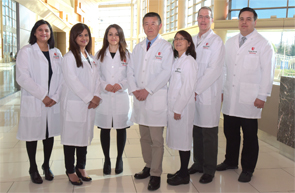Although these four individuals laid the foundation for a strong division, significant recruitment of physician–scientists, board certified in allergy, rheumatology or both, continued well until the end of 1980s. These recruits were Max Hamburger, MD (NIH); Lewis Yecies (NIH); and David Volkman, MD, PhD, allergist and cellular immunologist (NIH); Ray Dattwyler, MD, immunologist/rheumatologist (Boston); and Charles Steinman MD/rheumatologist (NYU).
National Leadership Established
By 1994, the division had grown to 11 full-time faculty, seven individual research laboratories, with an annual research budget of $3.5 million (including federal, state and private funding), seven fellows, several postdoctoral researchers and a combined support staff of 55. Due to his outstanding leadership, Dr. Kaplan was offered an opportunity to become director of the National Institute of Arthritis, Musculoskeletal, and Skin Institute at NIH, but he ultimately chose to stay at Stony Brook.
During this period of time, a reshuffling of leadership within the division/department of medicine took place, too. In 1987, Dr. Harry Fritts retired, and Dr. Kaplan was appointed to succeed as chairman of medicine. Dr. Gorevic was appointed to lead the Division of Allergy/Rheumatology and Clinical Immunology.
During the subsequent seven to eight years, the division grew well and flourished, and it received one of the National Allergy Center Grants for much of this period in addition to individual research grants. As a result, the division produced a considerable impact in rheumatology as well as allergy and clinical immunology at both national and international levels. For example, Dr. Kaplan was elected president of the American Academy of Allergy, Asthma, and Clinical Immunology from 1989–1990, president of the Clinical Immunology Society from 1990–1991 and president of the World Allergy Organization from 1990–1993.

The Center of Autoinflammatory Diseases in March 2016. From left: Asha Patnaik, MD, Julie Cherian, MD, Ayse Bag Ozbek, MD, Qingping Yao, MD, PhD, Ellen Li, MD, James Bliska, PhD, and Henry Neumann, MD.
The Department of Medicine also made excellent strides; during the first four years of Dr. Kaplan’s chairmanship, the research budget tripled and the clinical incomes quadrupled. In fact, the Department of Medicine research budget in 1991, according to Stony Brook President John Marburger, exceeded that of any department in the SUNY system, including all the basic sciences.
Since the 1980s, the division has trained approximately 60 clinical fellows in rheumatology and allergy/immunology, and some of the early trainees have become past and current chiefs/directors in the fields.
Change
Unfortunately, a downturn of the division started immediately after Dr. Kaplan stepped down from chairman of medicine in September 1994, and in April 1997, he left Stony Brook to assume a new leadership position at the Medical University of South Carolina. Dr. Gorevic left the division, too, and assumed a position as director of the Division of Rheumatology at the Icahn School of Medicine at Mount Sinai in New York. Consequently, there was a huge vacuum in the division, resulting in an accelerated downhill spiral.



